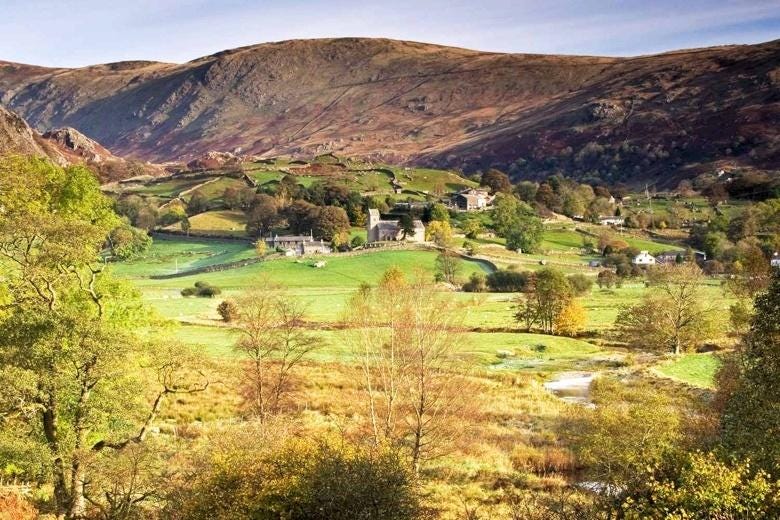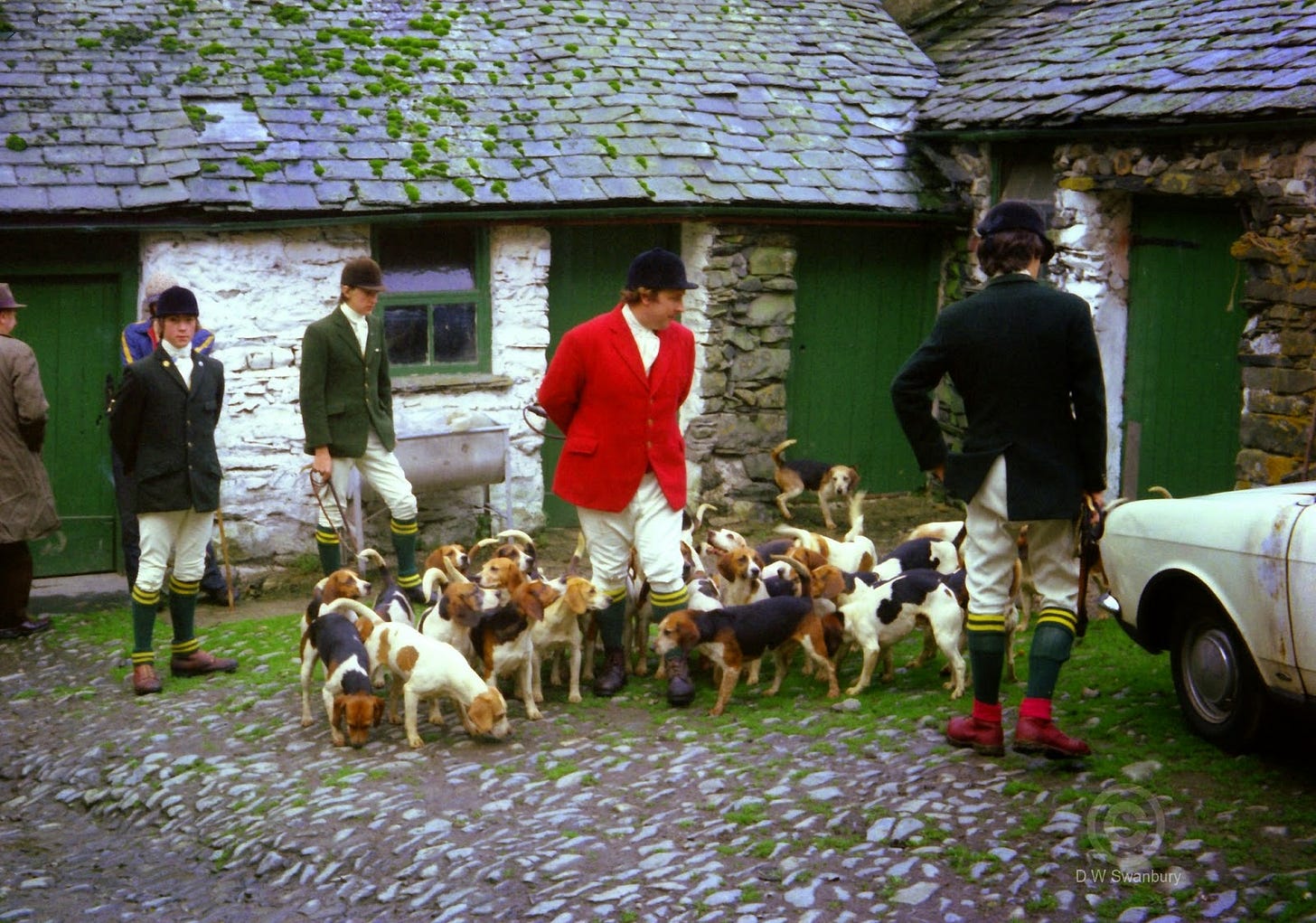Clara Black was a doughty farmer who lived, and may still live, in a farmhouse on a narrow winding lane almost at the end of the Kentmere Valley in Westmoreland.
(Remember Westmoreland? I don’t hold with ‘Cumbria’. I resent the erosion of county lines - county lines of the geographical not the drug-sales-territory variety - just because Bigger is somehow Better. I’m the parochial version of those people beginning to believe that Globalisation isn’t necessary. After all, Francis Drake succeeded in trading internationally with only the odd Armada to contend with and without reams of paperwork, and Globalisation doesn’t seem to have distributed more food to more people, only cheaply-made clothing to westerners. What really does need a thorough overhaul is Capitalism.)
The Kentmere Valley is the source of the River Kent that meanders then rushes down to Kendal, tourist gateway to the Lake District. When I was a teenager, Clara Black was its unofficial monarch. She rolled her Rs in her throat like a speaker of French and strode around her farm with stray babies, some of them her family’s, some of them the progeny of random fell walkers she waylaid, tucked under her arm like a marrow, and thwacking at thistles with the stave she clutched in her other hand. She kept Hamish, a white horse with a thick fur pelt, in a field that ran along the lane. My father would feed him Polo Mints each time he walked by. Immediately Clara would bustle-rush noisily out of the kitchen and into the field to scold him. “Grrraham! Polo Mints and horses arrrre not meant forrrr each other.”
There was always something of interest happening at her farm. When the Holme Valley Beagles from West Yorkshire visited the Lakes every year, ostensibly to chase after hares but a good deal of their time was spent convening in a pub for a traditional ‘singing do’, the hounds were boarded at Clara's.
If ever in the limelight, she rose to the occasion. She once won a spot on a local BBC radio quiz show which made her laugh so much on air she could neither remember the questions nor answer them, which in turn had the audience in stitches. Naturally, she became President of the Kentmere Sheep Show, relishing the photo ops with the winners.
One summer, Hamish’s field turned gold with a suddenly eruption of chanterelle mushrooms. Passing the dry-stone wall and espying them, I jumped the gate to fill my jacket. Clara tore out of her kitchen shouting, “Drrrop them, drrrop them! They’re drrreadfully poisonous!”
I declared myself on a mission to save Hamish from an uncomfortable death and was simply removing them from him as far as possible and would put them in the bin the minute I got home. She raised a sceptical brow and hauled me into her kitchen for a glass of elderberry wine.
People would drag themselves miles up the surrounding fells to give the farm a wide berth in the hopes they wouldn’t be spotted by the hospitable Clara with a glass of her elderberry wine to foist upon them. It was a viscous liquid of Stygian darkness, thick as cough syrup, sickly sweet. Cookery writers who include in their tomes a fashionable chapter on foraging will write lyrically on the properties of the elderflower, as I am about to myself, and will provide a recipe for elderflower cordial, as I am about to myself. But rarely will you find a recipe to support turning the berry into a quaffable wine.

This is the time of year elderflowers begin to appear like white parasols stretched by the wind to inside-out point. As soon as their umbels start to blossom, grab a bag and go out to pick them. They are readily available in town and country and among the most rewarding of foraged hedgerow flowers, though it is probably wiser to avoid picking from bushes growing along high traffic areas where diesel and petrol fumes are likely to become assumed by them.
Just three or four heads left a while to infuse a hot syrup, a cream or a fruit fool (it’s a natural partner to gooseberry) will add a highly scented flavour. You can even dip them in batter, fry them and sprinkle with fine sugar. But turn them into a cordial and you have a drink to which you can add iced water, soda water, a Crémant or Prosecco that adds a Muscatel grape taste to your drink. It’s a cordial that was hugely popular in Victorian times but goes all the way back to the Romans.
On a dry day while the blossoms have not matured enough to lose their vital pollen, pick 24 to 30 heads of elderflower. Any that are housing insects need a good shake but since the final cordial will be strained, you can eliminate any strays then. Place the flowers into a large bowl. Scrub 2 lemons then slice them finely and add to the flowers. Heat 3 pints of water containing 2.2lbs/1 kg sugar and stir till the sugar has melted then pour it over the flowers. Allow to steep for 24 hours then strain through a colander lined with muslin, cheesecloth or a double layer of paper towel. Pour into a clean pan, add 55g/2 oz citric acid and bring quickly to the boil. Remove at once, allow to cool, then pour through a funnel into sterilized bottles. The citric acid will allow the cordial to be stored in a dark place for a few months. If you don’t use it, store the bottles in the fridge. To serve, dilute to taste over ice in a ratio of 1 part cordial to 5 parts water or Prosecco or white wine.








I'm fond of St. Germaine elderflower liqueur, and enjoy it with Hendricks gin in place of vermouth, with a twist. We planted an elder when we moved to Maine. It has grown larger every year and produces abundantly, but the flowers don't have the haunting aroma that I associate with St. Germaine or the Scandinavian elderflower syrups I have tasted. I allow the flower umbrels to mature into berries, and have had great success making jam, cordial, and syrup; I add a good dose of St. Germaine to all of them to provide the full elder experience. Elderberry is held in great esteem here as an immune system booster, and I have been taking an almost daily dose since the covid pandemic began. I don't know if this folk medicine lore is genuine or not, and I am not depending on it, I'm wearing a mask indoors, and have gotten all vaccine doses and boosters, too. But so far, knock wood, the elderberry is working! Plus, I find it delicious.
What a complete delight to read of Kentmere, Clara Black and see those beautiful photos. Lake District lovers will - I am sure- enjoy this evocative description. Thanks you.